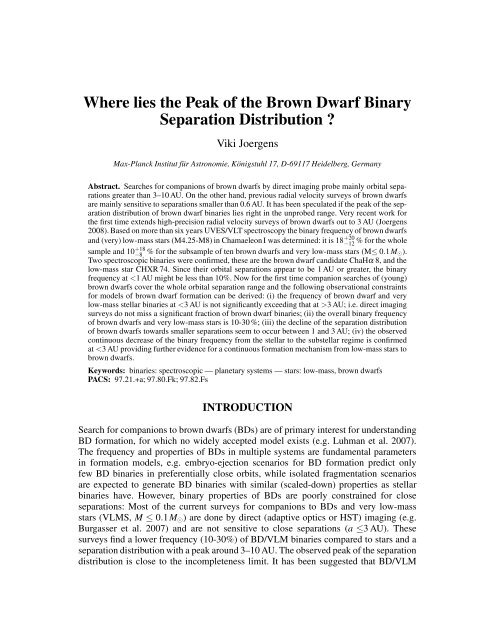Where lies the Peak of the Brown Dwarf Binary Separation ...
Where lies the Peak of the Brown Dwarf Binary Separation ...
Where lies the Peak of the Brown Dwarf Binary Separation ...
Create successful ePaper yourself
Turn your PDF publications into a flip-book with our unique Google optimized e-Paper software.
<strong>Where</strong> <strong>lies</strong> <strong>the</strong> <strong>Peak</strong> <strong>of</strong> <strong>the</strong> <strong>Brown</strong> <strong>Dwarf</strong> <strong>Binary</strong><br />
<strong>Separation</strong> Distribution ?<br />
Viki Joergens<br />
Max-Planck Institut für Astronomie, Königstuhl 17, D-69117 Heidelberg, Germany<br />
Abstract. Searches for companions <strong>of</strong> brown dwarfs by direct imaging probe mainly orbital separations<br />
greater than 3–10 AU. On <strong>the</strong> o<strong>the</strong>r hand, previous radial velocity surveys <strong>of</strong> brown dwarfs<br />
are mainly sensitive to separations smaller than 0.6 AU. It has been speculated if <strong>the</strong> peak <strong>of</strong> <strong>the</strong> separation<br />
distribution <strong>of</strong> brown dwarf binaries <strong>lies</strong> right in <strong>the</strong> unprobed range. Very recent work for<br />
<strong>the</strong> first time extends high-precision radial velocity surveys <strong>of</strong> brown dwarfs out to 3 AU (Joergens<br />
2008). Based on more than six years UVES/VLT spectroscopy <strong>the</strong> binary frequency <strong>of</strong> brown dwarfs<br />
and (very) low-mass stars (M4.25-M8) in Chamaeleon I was determined: it is 18 +20<br />
−12 % for <strong>the</strong> whole<br />
sample and 10 +18<br />
−8 % for <strong>the</strong> subsample <strong>of</strong> ten brown dwarfs and very low-mass stars (M≤ 0.1M⊙).<br />
Two spectroscopic binaries were confirmed, <strong>the</strong>se are <strong>the</strong> brown dwarf candidate ChaHα 8, and <strong>the</strong><br />
low-mass star CHXR 74. Since <strong>the</strong>ir orbital separations appear to be 1 AU or greater, <strong>the</strong> binary<br />
frequency at
inaries with a separation 3 AU (Pinfield et al 2003; Maxted & Jeffries 2005; Burgasser et al. 2007). Hence,<br />
<strong>the</strong> peak <strong>of</strong> <strong>the</strong> BD/VLM binary separation distribution could lie below 3 AU. Given<br />
<strong>the</strong>se limits <strong>of</strong> <strong>the</strong> current observational data, <strong>the</strong> question arises if our current picture <strong>of</strong><br />
BD/VLM binaries is complete, or, whe<strong>the</strong>r we miss a significant fraction <strong>of</strong> very close<br />
and/or small mass ratio systems.<br />
Spectroscopic monitoring for radial velocity (RV) variations provides a means to<br />
detect very close binaries. While several spectroscopic surveys for companions <strong>of</strong><br />
BD/VLMS in young cluster (e.g. Joergens 2006; Maxted et al. 2008) and in <strong>the</strong> field (e.g.<br />
Guen<strong>the</strong>r & Wuchterl 2003; Basri & Reiners 2006) have been started in recent years,<br />
data sampling is sparse in most cases and <strong>the</strong> number <strong>of</strong> confirmed close companions to<br />
BD/VLMS is still small (only four, e.g. Stassun et al. 2006; Joergens & Müller 2007).<br />
Fur<strong>the</strong>rmore, <strong>the</strong> determination <strong>of</strong> <strong>the</strong> binary frequency <strong>of</strong> BD/VLMS in <strong>the</strong>se surveys<br />
is limited to ≤0.1–0.6 AU. This leaves still a significant unprobed gap between <strong>the</strong> separations<br />
studied by RV surveys and those probed by direct imaging surveys (>3 AU).<br />
This was closed recently by follow-up UVES observations within <strong>the</strong> framework <strong>of</strong> an<br />
RV survey in <strong>the</strong> Chamaeleon I star-forming region (Joergens 2008). It allowed for <strong>the</strong><br />
first time to probe <strong>the</strong> important separation range 1–3 AU for BD/VLMS, as outlined in<br />
<strong>the</strong> following.<br />
NEW RESULTS OF RV SURVEY IN CHA I<br />
An RV survey is carried out for close (planetary and BD) companions to very young<br />
BD/VLMS in Cha I with <strong>the</strong> UVES spectrograph at <strong>the</strong> VLT. Including very recent data<br />
(Joergens 2008), this survey is sensitive to companions at orbital distances <strong>of</strong> 3 AU and<br />
smaller with a detection rate <strong>of</strong> 50% or more, as shown by a Monte-Carlo simulation<br />
(see Fig. 1). For BD/VLM binaries with a mass ratio close to unity (q ≡ M2/M1 >0.8),<br />
<strong>the</strong> survey is sensitive to even larger separations. This is a significant extension to larger<br />
orbital separations compared to previous results <strong>of</strong> this survey (Joergens 2006) as well as<br />
compared to o<strong>the</strong>r RV surveys <strong>of</strong> young BD/VLMS (Kurosawa et al 2006; Prato 2007;<br />
Maxted et al. 2008), which cover separations ≤0.3 AU, and to o<strong>the</strong>r surveys <strong>of</strong> field<br />
BD/VLMS (Reid et al 2002; Guen<strong>the</strong>r & Wuchterl 2003; Basri & Reiners 2006), which<br />
cover separations ≤0.6 AU (comparison based on q between 0.2 and 1, 3.3 σ detection,<br />
50% detection probability; cf. Joergens 2008 for more details). Thus, for <strong>the</strong> first time,<br />
<strong>the</strong> binary frequency <strong>of</strong> BD/VLMS is probed for <strong>the</strong> whole separation range 12 years).
FIGURE 1. Comparison <strong>of</strong> detection probability <strong>of</strong> different BD/VLMS radial velocity surveys. Solid<br />
(red) line: Joergens 2008; dotted (black) line: Basri & Reiners 2006; dashed (blue) line: Guen<strong>the</strong>r<br />
& Wuchterl 2003; dash-dotted (green) line: Kurosawa et al. 2006. Calculation based on Monte-Carlo<br />
simulation. See text for more details on used parameters. From Joergens (2008).<br />
These spectroscopic binaries appear to have orbital periods <strong>of</strong> at least a few years, i.e.<br />
orbital separations <strong>of</strong> 1 AU or greater. There were no signs found for <strong>the</strong> presence <strong>of</strong><br />
shorter period companions around <strong>the</strong> targets. This is noteworthy because those cause<br />
larger RV signals and are, <strong>the</strong>refore, easier to detect. Thus, while <strong>the</strong> rate <strong>of</strong> BD/VLM<br />
binaries at ≤3 AU is found to be 10% (18% including CHXR 74), at separations
RV [km s -1 ]<br />
2<br />
1<br />
0<br />
-1<br />
-2<br />
2000 3000 4000 5000<br />
time [JD-2450000]<br />
FIGURE 2. Discovery <strong>of</strong> low-mass RV companion orbiting <strong>the</strong> young BD/VLMS ChaHα 8 based<br />
on UVES/VLT data obtained between 2000 and 2008 (partly published in Joergens & Müller 2007).<br />
Overplotted is <strong>the</strong> best-fit Kepler orbit (semi-amplitude 1.6 km s −1 , period 4.8 years, eccentricity e=0.28).<br />
The derived estimate (model dependent) for <strong>the</strong> companion minimum mass M2 sini is 17–22 MJup.<br />
into <strong>the</strong> BD regime (e.g. Burgasser et al. 2007) is confirmed here for separations
















